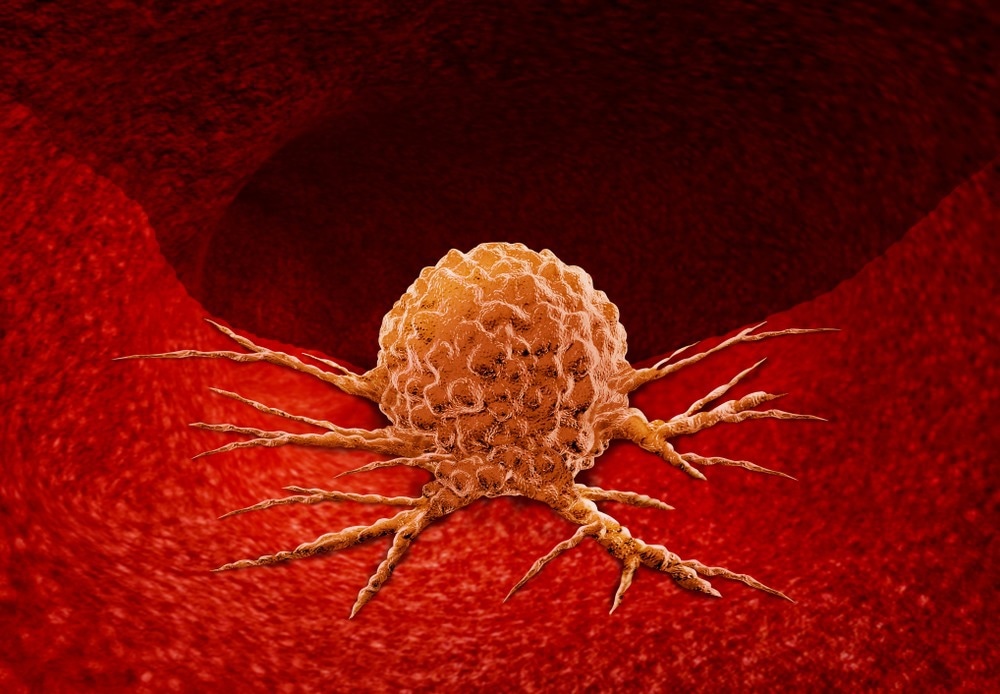Cancer photo-immunotherapy (CPIT) is a promising strategy that triggers the release of hostile signals on irradiating with an appropriate dose of laser to unveil primary tumor immunogenicity while activating adaptive immunity to suppress distant metastases.

Study: Self-Splittable Transcytosis Nanoraspberry for NIR-II Photo-Immunometabolic Cancer Therapy in Deep Tumor Tissue. Image Credit: Lightspring/Shutterstock.com
Nevertheless, various factors of photo-immunotherapy, including poor penetration of photothermal agents (PTAs) or immuno-regulators, disordered Immunometabolism, and poor penetration of laser into the deep tumor regions, resulted in ineffective therapeutic outcomes.
An article published in Advanced Science demonstrated a photo-immunometabolic cancer therapy utilizing a second near-infrared window (NIR-II) and programmed raspberry-structured nanoadjuvants that effectively potentiated the immunogenic cell death (ICD) in deep tumor tissue and prevented immunometabolic disorders.
Programmed raspberry-structured nanoadjuvants were developed via self-assembly of indoleamine 2,3-dioxygenase 1 (IDO-1) inhibitor modified with small-sized copper sulfide (CuS5) nanoparticles and a cationized polymeric matrix that was sensitive to the tumor microenvironment (TME).
TME induced the splitting of the nanoadjuvants into CuS5, with significant transcytosis potential and the ability to suppress TME immunometabolic activity. On subjecting nanoadjuvants to NIR-II irradiation, CuS5 induced the ICD and released an immunometabolic regulator into deep tumor tissues, improving IDO-1 mediated immunometabolic disorder and suppressing regulatory T cell infiltration. The photo-immunometabolic cancer therapy mediated by programmed nanoadjuvants delayed the 4T1 tumor growth, inhibiting detrimental pulmonary metastasis.
Photoimmunotherapy For Cancer Treatment
Cancer immunotherapy has significantly evolved during the past few years due to an improved understanding of the underlying principles of tumor biology and immunology. These principles have been critical in developing immunotherapy in the laboratory and its implementation in the clinic. This improved understanding of immunotherapy is enhanced by increased insights into the mechanism of tumor immune response and its evasion by tumors.
Photoimmunotherapy is an oncological treatment that combines photodynamic therapy (PDT) of the tumor with immunotherapy treatment. Combining PDT with immunotherapy enhances the immunostimulating response and has synergistic effects for metastatic cancer treatment. Hyperthermia caused by laser irradiation induces ICD that is associated with the release of damage-associated molecular patterns (DAMPs) extracellularly.
Photothermal therapy (PTT) can be an effective anti-tumor therapy, but it may not eliminate tumor cells, leading to the risk of recurrence or metastasis. Moreover, due to poor penetration ability, PTA was not efficient in inducing immunogenicity in deep tumor tissues and caused an inhomogeneous release of DAMPs, making the localized tumor regions “cold” towards immunotherapy. Thus, improving the deep and homogenous penetration of PTAs and increasing light penetration depth in tumor tissues is critical for PTT-induced immune stimulation.
Tumor-associated antigens such as specific proteins or peptides may induce robust anti-tumor immune responses with the help of nanoadjuvants. Accordingly, few nanomaterials may trigger immune-activating effects that lead to immunotherapy mediated by nanoadjuvants.
As per previous reports, many nanoadjuvants have favorable immune properties, such as strong adjuvanticity and simplified preparation. However, there is still a demand for potential nanoadjuvants that could integrate powerful adjuvanticity, excellent biocompatibility, biodegradability, and multiple mechanisms of immunomodulation.
Photo-Immunometabolic Cancer Therapy Utilizing Programmed Nanoadjuvants
Previous tumor immunological studies mentioned that the metabolic TMS suppresses the cytotoxicity T lymphocyte (CTL)-based anti-tumor response, weakening the ICD-induced immune performance. Excess IDO-1 in tumors leads to the production of abundant kynurenine that suppresses CTL’s activity. Besides, kynurenine also impairs anti-tumor immunity via activating the immunosuppressive regulatory T cells (Tregs).
Thus, accumulation of CTLs at tumor sites, regulation of immunosuppressive TME, and systemic immune surveillance are effective strategies to inhibit primary tumor growth and metastasis. The present work proposed a NIR-II photo-immunometabolic cancer therapy, utilizing programmed raspberry-shaped nanoadjuvants with transformable charge and size and immunometabolic regulation ability in deep tumor tissues.
The programmed nanoadjuvants showed strong absorbance in the NIR-II region, confirmed by UV-Vis-NIR-II spectroscopy. The nanoadjuvants were constructed by IDO inhibitor, 1-methyl-tryptophan (1-MT), and were conjugated with CuS5 nanoparticles via a TME-responsive polymer matrix.
The main advantage of the programmed nanoadjuvants is that they have a neutral surface charge and dissociate into CuS5 with a positive surface charge when exposed to the TME conditions. Thus, demonstrating the transformable ability of programmed raspberry-shaped nanoadjuvants.
Moreover, the dissociated CuS5 were internalized rapidly by the tumor cells and penetrated deep tumor tissues via passive diffusion and active transcytosis, confirming the advantage of photo-immunometabolic cancer therapy over PTT or PDT. In addition, the strong absorption in the NIR-II window improved the photothermal performance of CuS5 to generate considerable heat in deep tumor tissues.
Furthermore, the 1-MT release from programmed raspberry-shaped nanoadjuvants effectively suppressed the activity of IDO, minimizing immunometabolic disorders, thus, sensitizing the photo-immunometabolic cancer therapy.
Conclusion
To summarize, a photo-immunometabolic cancer therapy was developed by loading the TME responding transcytosis-based nanoadjuvants with an immunometabolic regulator. Nanoadjuvants showed strong absorbance in the NIR-II window and potential for active transcytosis.
NIR-II irradiation-induced penetration of programmed raspberry-structured nanoadjuvants into tumor tissues improved the photothermal performance and featured massive tumor-associated antigen exposure in deep tumor tissues. The antigen exposure stimulated the maturation of dendritic cells and activated the immune system. 1-MT-loaded nanoadjuvants suppressed immunometabolic TME, evoking an increased infiltration of CTLs and attenuating the Treg infiltration.
Combining the photo-immunometabolic cancer therapy based on nanoadjuvants with α-PD1 inhibited lung metastasis and extended the survival time of 4T1 tumor-bearing mice. Thus, the present study offered an effective strategy to improve photo-immunometabolic cancer therapy outcomes for treating primary and metastatic tumors.
Reference
Wang, L., Jiang, W., Su, Y., Zhan, M., Peng, S., Liu, H., Lu, L. (2022). Self-Splittable Transcytosis Nanoraspberry for NIR-II Photo-Immunometabolic Cancer Therapy in Deep Tumor Tissue. Advanced Sciences. https://onlinelibrary.wiley.com/doi/10.1002/advs.202204067
Disclaimer: The views expressed here are those of the author expressed in their private capacity and do not necessarily represent the views of AZoM.com Limited T/A AZoNetwork the owner and operator of this website. This disclaimer forms part of the Terms and conditions of use of this website.